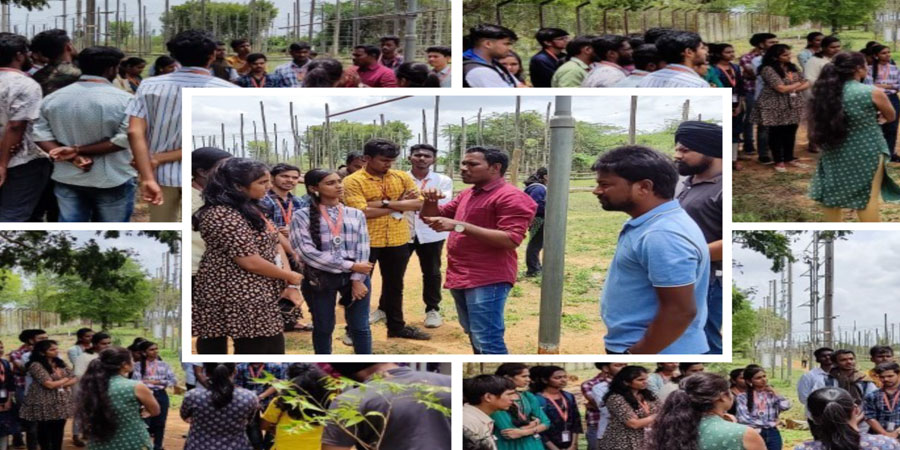Industrial Visit to Gauribidanur Radio Observatory
Introduction:
The Astronomy club associated with Department of Aeronautical and Aerospace Engineering, MVJ College of Engineering organized an industrial visit to the Gauribidanur Radio Observatory, a significant radio astronomy facility operated by the Indian Institute of Astrophysics (IIA) on 02nd August 2023. The visit aimed to introduce 40 astronomy club students from aeronautical, aerospace, computer science, and electronics communication engineering along with Dr. Manikandan P, Assistant Professor, Department of Aerospace Engineering to the field of radio astronomy and its importance in space research. The observatory, located in Gauribidanur, Chikkaballapur District, India, has been in operation since 1976 and plays a vital role in advancing radio astronomy research in the country.
Facilities and Instruments at Gauribidanur Radio Observatory:
During the visit, the group of students had the opportunity to explore various facilities and instruments at the Gauribidanur Radio Observatory. It included:
- GEETEE (Gauribidanur Decametric Wave Radio Telescope): The GEETEE facility consists of 1000 dipoles arranged in a 'T' configuration, with a 1.4 km East-West arm and a 0.5 km South arm. Operating at a frequency of 34.5 MHz, GEETEE is primarily dedicated to studying radio waves from the Sun and other celestial objects. Students learned about the telescope's achievements, which included obtaining the first two-dimensional images of radio emission from the outer solar corona and conducting an all-sky survey of radio sources.
- GRAPH (Gauribidanur Radio Heliograph): GRAPH is a radioheliograph that captures two-dimensional images of the solar corona at different frequencies (40 - 150 MHz) using 384 log-periodic dipole (LPD) elements. Students witnessed the unique frequency coverage provided by GRAPH, enables detailed studies of the solar corona's height range, which is challenging to observe at other frequencies.
- GLOSS (Gauribidanur Low-Frequency Solar Spectrograph): GLOSS, a high-resolution radio spectrograph operating in conjunction with GRAPH, uses eight log periodic dipoles to obtain dynamic spectra of transient emissions from the solar corona. Students learned about its role in providing spectral and positional information on eruptive solar activity.
- GRIP (Gauribidanur Radio Interferometric Polarimeter): GRIP, a one-dimensional east-west array of 40 log periodic dipoles, probes the coronal magnetic field between 0.2 and 0.8 solar radii above the solar surface. Students discovered how GRIP's observations of circularly polarized radio emission provide insights into the characteristics of the coronal magnetic field.

Experts Explaining about Radio Field Station to the Students

Researcher Briefing about Extract information from Radio Observatories
Educational Outcomes:
The industrial visit to Gauribidanur Radio Observatory enriched the understanding of the 40 students from aeronautical, aerospace, computer science, and electronics communication engineering in the field of radio astronomy, space science, and research. The following educational outcomes were achieved:
- Introduction to Radio Astronomy: Students received a comprehensive introduction to radio astronomy and its significance in studying celestial objects and phenomena. They learned about the complementary nature of radio observations to optical and other types of observations.
- Understanding Solar Physics: The visit enhanced the students' understanding of solar physics, including solar flares, coronal mass ejections, and solar radio bursts. They explored how radio telescopes like GEETEE and GRAPH contribute to the study of the Sun's behaviour.
- Exposure to Advanced Telescopes: Students were introduced to state-of-the-art radio telescope technology. They observed the engineering and design intricacies behind the telescope array, its operational processes, and its data collection methods from celestial sources
- Interdisciplinary Learning: Students appreciated the interdisciplinary nature of radio astronomy, involving physics, astronomy, engineering, and computer science. They learned how different disciplines collaborate to advance our understanding of the universe.
- Exploration of Space Research: The visit sparked interest in space research and exploration. Students learned about ongoing space missions, satellite communication, and the role of radio telescopes in space exploration.
- Career Opportunities: Exposure to radio astronomy and space research inspired some students to consider careers in these fields. They explored various career opportunities, including astrophysicists, radio astronomers, engineers, data analysts, and research scientists.
- Appreciation for Scientific Research: Students developed an appreciation for scientific inquiry and research. They understood the dedication and effort required to pursue scientific discoveries.
- Awareness of International Collaborations: Students learned about international collaborations and partnerships in radio astronomy research. They appreciated how countries come together to share knowledge and resources for space exploration.
- Awareness of Indian Contributions: Visiting an Indian radio telescope facility highlighted India's contributions to space research and astronomy. Students developed a sense of pride in their country's achievements in this field.
Conclusion:
The industrial visit to the Gauribidanur Radio Observatory was a transformative experience for the group of 40 students from Aeronautical, Aerospace, computer science, and electronics communication engineering. It ignited the curiosity about space, astronomy, and scientific research while providing valuable insights into cutting-edge technology, research methods, and the role of radio astronomy in advancing our understanding of the universe. The visit promoted interest in the field of astronomy and related projects, inspiring potential future scientists, and researchers in India. We extend our gratitude to the Indian Institute of Astrophysics and Gauribidanur Radio Observatory for facilitating this enlightening and informative visit.
Dr P Manikandan
Event Co-Ordinator,
Assistant Professor, Department of Aerospace Engineering
MVJCE.
Prof. S Arul Murugan
Event Co-Ordinator,
Assistant Professor, Department of Aerospace Engineering
MVJCE.





